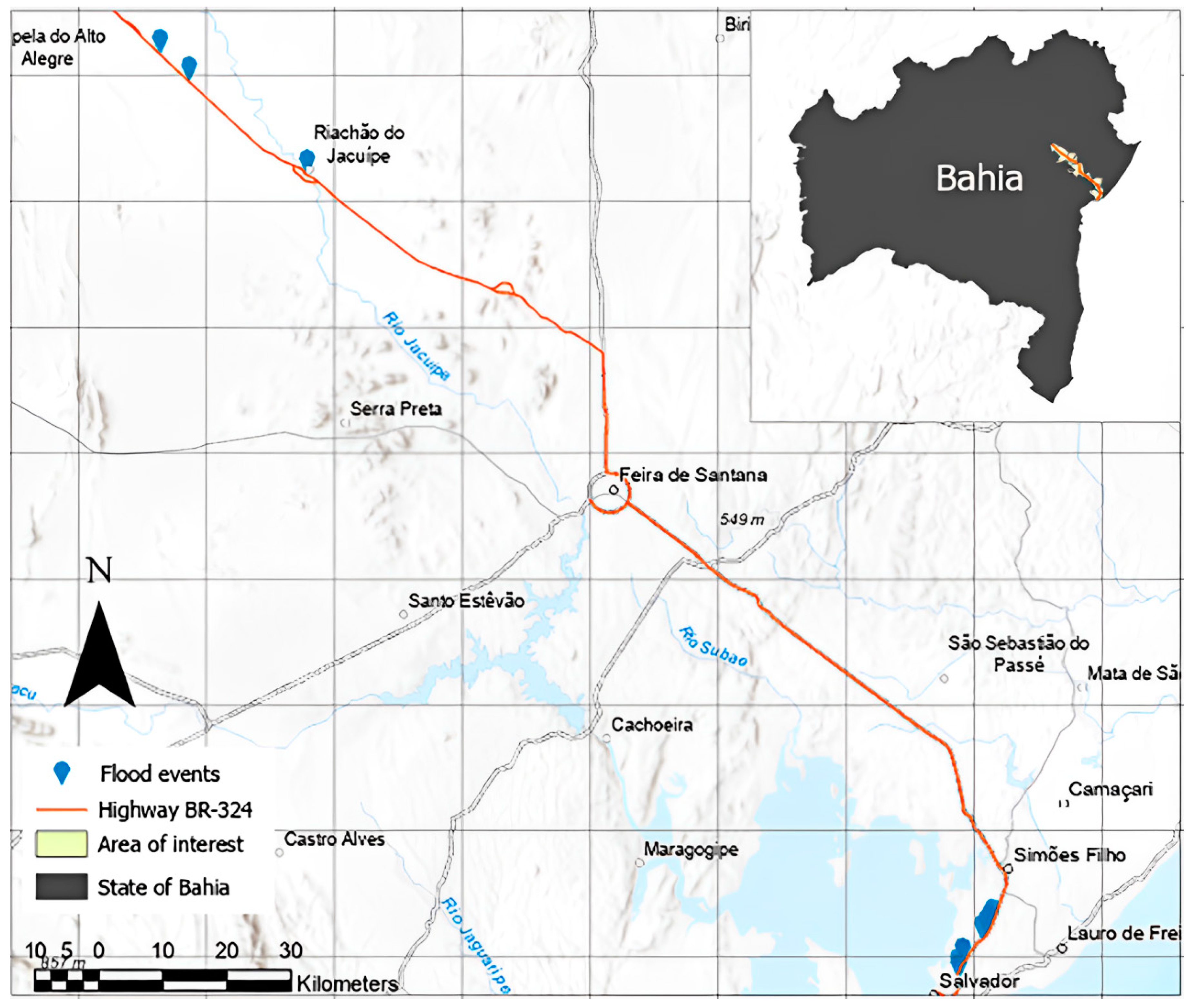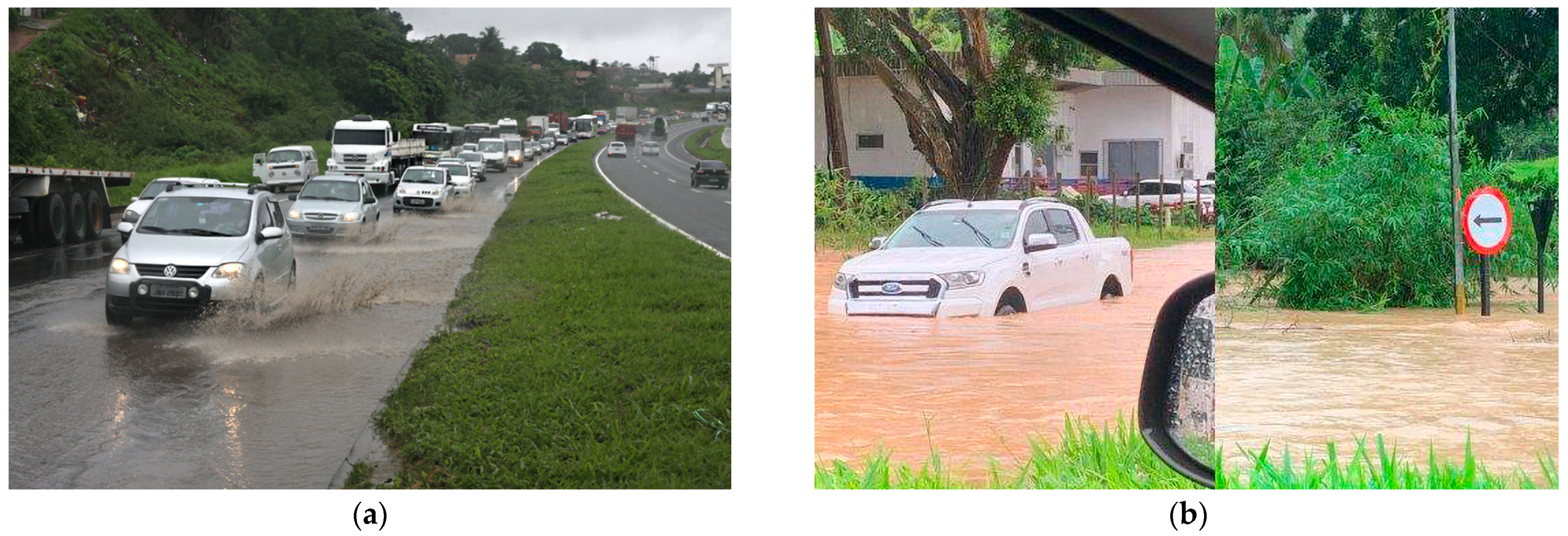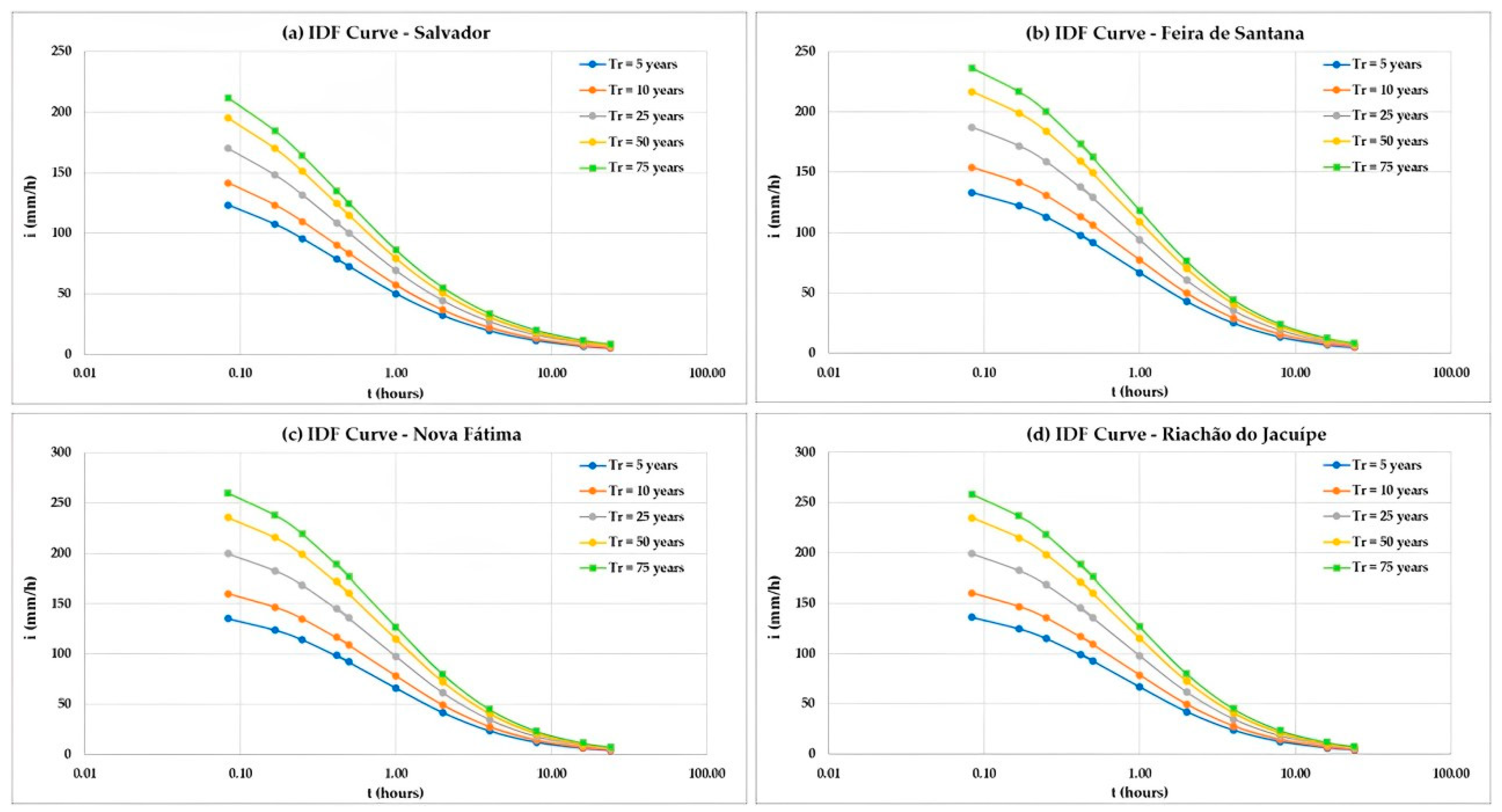Enhancing Risk Management in Road Infrastructure Facing Flash Floods through Epistemological Approaches
Abstract
:1. Introduction
2. Literature Review
2.1. Uncertainty in Risk Management
2.2. Theoretical Approach in Risk Management and Risk Assessment
2.3. Flood Risk Assessment
2.4. Pavement Failure Risk Assessment
3. Materials and Methods
3.1. Integrative Approach to Addressing Uncertainty
3.2. Case Study
4. Results
4.1. Rainfall Analysis
4.2. Analysis of Underlying Causes and Response Strategies
5. Discussion
6. Conclusions
Author Contributions
Funding
Data Availability Statement
Conflicts of Interest
References
- Allen, B.; Grogg, M.; Smith, K.; Pai, S. Improving the Link between Pavement Design and Asset Management: A Pavement Management Primer for Pavement Engineers; Applied Pavement Technology, Inc.: Urbana, IL, USA, 2022; S. FHWA-HIF-22-068. [Google Scholar]
- Akintoye, A.S.; MacLeod, M.J. Risk analysis and management in construction. Int. J. Proj. Manag. 1997, 15, 31–38. [Google Scholar] [CrossRef]
- Alkhawaja, A.S.I.; Varouqa, I.F. Risks management of infrastructure line services and their impact on the financial costs of road projects in Jordan. Meas. Sens. 2023, 25, 100647. [Google Scholar] [CrossRef]
- Malek, S.S.; Pathan, N.I.; Mal, H. Risk Management in Construction Industry. Indian J. Appl. Res. 2011, 3, 377–379. [Google Scholar] [CrossRef]
- Fevranoglou, G.; Diakaki, C. Risk management in construction projects: A study on the state-of-practice. Int. J. Decis. Sci. Risk Manag. 2019, 8, 197. [Google Scholar] [CrossRef]
- Myrczek, J.; Juraszek, J.; Tworek, P. Risk management analysis in construction enterprises in selected regions in Poland. Tech. Trans. 2020, 117, 1–13. [Google Scholar] [CrossRef] [PubMed]
- Osei-Kyei, R.; Narbaev, T.; Ampratwum, G. A Scientometric Analysis of Studies on Risk Management in Construction Projects. Buildings 2022, 12, 1342. [Google Scholar] [CrossRef]
- Baloyi, T.; Ozumba, A. Strategic Risk Management among Small Enterprises in the Construction Industry. MATEC Web Conf. 2020, 312, 02013. [Google Scholar] [CrossRef]
- Chenya, L.; Aminudin, E.; Mohd, S.; Yap, L.S. Intelligent Risk Management in Construction Projects: Systematic Literature Review. IEEE Access 2022, 10, 72936–72954. [Google Scholar] [CrossRef]
- Taleb, N.N. The Black Swan: The Impact of the Highly Improbable; Random House: New York, NY, USA, 2007; Available online: https://www.rh-newsletters.com (accessed on 11 March 2024).
- Lütge, C. Business Ethics and Risk Management; Springer: Dordrecht, The Netherlands, 2014; p. 43. [Google Scholar] [CrossRef]
- Hayes, M.V. On the epistemology of risk: Language, logic and social science. Soc. Sci. Med. 1992, 35, 401–407. [Google Scholar] [CrossRef]
- Hansson, S. The Epistemology of Technological Risk. SPT 2005, 9, 1–5. Available online: https://scholar.lib.vt.edu/ejournals/SPT/v9n2/hansson.html (accessed on 10 February 2024).
- Zheng, E.Z.H.; de Carvalho, M.M. Managing Uncertainty in Projects: A Review, Trends and Gaps. Rev. Gest. Projetos 2016, 7, 95–109. [Google Scholar] [CrossRef]
- Sahlin, U.; Helle, I.; Perepolkin, D. ‘This Is What We Don’t Know’: Treating Epistemic Uncertainty in Bayesian Networks for Risk Assessment. Integr. Environ. Assess. Manag. 2021, 17, 221–232. [Google Scholar] [CrossRef]
- Shome, N.; Rahnama, M.; Jewson, S.; Wilson, P. Quantifying Model Uncertainty and Risk. In Risk Modeling for Hazards and Disasters; Elsevier: Amsterdam, The Netherlands, 2018; pp. 3–46. [Google Scholar] [CrossRef]
- Migilinskas, D.; Ustinovicius, L. Methodology of risk and uncertainty management in construction’s technological and economical problems. In Proceedings of the 25th International Symposium on Automation and Robotics in Construction, Vilnius, Lithuania, 26–29 June 2008; Vilnius Gediminas Technical University Publishing House Technika: Vilnius, Lithuania, 2008; pp. 789–795. [Google Scholar] [CrossRef]
- Al Hasani, M.; Regan, M. Understanding Risk and Uncertainty Management Practice in Complex Projects. Eur. J. Econ. Law Polit. 2017, 4. [Google Scholar] [CrossRef]
- Beven, K.J.; Aspinall, W.P.; Bates, P.D.; Borgomeo, E.; Goda, K.; Hall, J.W.; Watson, M. Epistemic uncertainties and natural hazard risk assessment—Part 2: What should constitute good practice? Nat. Hazards Earth Syst. Sci. 2018, 18, 2769–2783. [Google Scholar] [CrossRef]
- Morales-Torres, A.; Escuder-Bueno, I.; Serrano-Lombillo, A.; Castillo Rodríguez, J.T. Dealing with epistemic uncertainty in risk-informed decision making for dam safety management. Reliab. Eng. Syst. Saf. 2019, 191, 106562. [Google Scholar] [CrossRef]
- Damnjanovic, I.; Reinschmidt, K. Data Analytics for Engineering and Construction Project Risk Management. In Risk, Systems and Decisions; Springer International Publishing: Texas, TX, USA, 2020. [Google Scholar] [CrossRef]
- Marshall, A.; Ojiako, U. Managing risk through the veil of ignorance. J. Risk Res. 2013, 16, 1225–1239. [Google Scholar] [CrossRef]
- Babic, B. A Theory of Epistemic Risk. Philos. Sci. 2019, 86, 522–550. [Google Scholar] [CrossRef]
- Covello, V.; Lave, L.; Moghissi, A.; Uppuluri, V. Uncertainty in Risk Assessment, Risk Management, and Decision Making; Springer US: Boston, MA, USA, 1987. [Google Scholar] [CrossRef]
- Engemann, K.J.; Miller, H.E.; Yager, R.R. A general methodology for decision making under uncertainty with a risk management application. In Proceedings of the 2nd International Symposium on Uncertainty Modeling and Analysis, College Park, MD, USA, 25–28 April 1993; IEEE Computers Society Press: Washington, DC, USA, 1993; pp. 194–199. [Google Scholar] [CrossRef]
- Richardson, J.G. The certainty of uncertainty: Risk management revisited. Foresight 2010, 12, 47–64. [Google Scholar] [CrossRef]
- Bevan, L.D. The ambiguities of uncertainty: A review of uncertainty frameworks relevant to the assessment of environmental change. Futures 2022, 137, 102919. [Google Scholar] [CrossRef]
- Bojórquez-Tapia, L.A.; Eakin, H.; Reed, P.M.; Miquelajauregui, Y.; Grave, I.; Merino-Benítez, T.; Molina-Pérez, E. Unveiling uncertainties to enhance sustainability transformations in infrastructure decision-making. Curr. Opin. Environ. Sustain. 2022, 55, 101172. [Google Scholar] [CrossRef]
- Itabashi-Campbell, R.; Gluesing, J.; Perelli, S. Mindfulness and product failure management: An engineering epistemology. Int. J. Qual. Reliab. Manag. 2012, 29, 642–665. [Google Scholar] [CrossRef]
- Kant, V.; Kerr, E. Taking Stock of Engineering Epistemology: Multidisciplinary Perspectives. Philos. Technol. 2019, 32, 685–726. [Google Scholar] [CrossRef]
- Rumpfkeil, M.P. Robust design under mixed aleatory/epistemic uncertainties using gradients and surrogates. J. Uncertain. Anal. Appl. 2013, 1, 7. [Google Scholar] [CrossRef]
- Cook, L.W.; Jarrett, J.P.; Willcox, K.E. Extending Horsetail Matching for Optimization Under Probabilistic, Interval, and Mixed Uncertainties. AIAA J. 2018, 56, 849–861. [Google Scholar] [CrossRef]
- Dantan, J.-Y.; Eifler, T. Integrated uncertainty management in parametric design and tolerancing. J. Eng. Des. 2021, 32, 517–537. [Google Scholar] [CrossRef]
- ISO 31000:2009; Risk Management—Principles and Guidelines. International Organization for Standardization: Geneva, Switzerland, 2009.
- Buchtik, L. Secretos para Dominar la Gestión de Riesgos en Proyectos; Buchtik Global: Montevideo, Uruguay, 2012. [Google Scholar]
- Guerrero-Aguiar, M.; Medina-Leon, A.; Nogueira-Rivera, D. Procedimiento de gestión de riesgos como apoyo a la toma de decisiones. Ing. Ind. 2019, 41, 1–14. [Google Scholar]
- Martinez Hernandez, R.; Blanco Dopico, M.I. Gestión de riesgos: Reflexiones desde un enfoque de gestión empresarial emergente. Rev. Venez. Gerenc. 2017, 22, 693–711. [Google Scholar] [CrossRef]
- Srinivas, K. Process of Risk Management. In Perspectives on Risk, Assessment and Management Paradigms; IntechOpen: London, UK, 2019. [Google Scholar] [CrossRef]
- Amuzu, J.; Jallow, B.; Kabo-Bah, A.; Yaffa, S. The climate change vulnerability and risk management matrix for the coastal zone of the Gambia. Hydrology 2018, 5, 14. [Google Scholar] [CrossRef]
- IPCC. Climate Change 2014: Synthesis Report. Contribution of Working Groups I, II and III to the Fifth Assessment Report of the Intergovernmental Panel on Climate Change; Cambridge University Press: Cambridge, UK, 2014. [Google Scholar]
- Thompson, P.B. The Philosophical Foundations of Risk. South J. Philos. 1986, 24, 273–286. [Google Scholar] [CrossRef]
- Doorn, N. Lotte Asveld and Sabine Roeser (eds), The Ethics of Technological Risk. Sci. Eng. Ethics 2009, 15, 259–261. [Google Scholar] [CrossRef]
- Lu, D. Pavement Flooding Risk Assessment and Management in the Changing Climate; University of Waterloo: Waterloo, ON, Canada, 2019. [Google Scholar]
- GPRH—Grupo de Pesquisa em Recursos Hídricos. Modelo Físico-Matemático para o Controle da Erosão Hídrica nas Condições Edafoclimáticas Brasileiras; Viçosa UFV: Viçosa, Brazil, 2008; p. 78. Available online: http://www.gprh.ufv.br/?area=modelo_fisico_matematico (accessed on 3 March 2024).
- United Nations International Strategy for Disaster Reduction (UNISDR). The Human Cost of Weather-Related Disaster 1995–2005. Available online: https://www.preventionweb.net/publications/view/46796 (accessed on 8 April 2024).
- Little, D.N.; Jones, D.R.J. Moisture Sensitivity of Asphalt Pavements; University of California: Berkeley, CA, USA, 2003. [Google Scholar]
- Brasil; Departamento Nacional de Infra-Estrutura de Transportes; Diretoria de Planejamento e Pesquisa; Coordenação Geral de Estudos e Pesquisa; Instituto de Pesquisas Rodoviárias. IPR Publ. 724. In Manual de Drenagem de Rodovias, 2nd ed.; DNIT: Rio de Janeiro, Brazil, 2006; p. 333. [Google Scholar]
- Vuong, B. Influence of density and moisture content on dynamic stress-strain behaviour of a low plasticity crushed rock. Road Transp. Res. 1992, 1, 88–100. [Google Scholar]
- Shahin, M.Y. Pavement Management for Airports, Roads, and Parking Lots, 2nd ed.; Springer: New York, NY, USA, 2005. [Google Scholar]
- Labi, S.; Sinha, K.C. Life-cycle evaluation of flexible pavement preventive maintenance. J. Transp. Eng. 2005, 131, 744–751. [Google Scholar] [CrossRef]
- Kırbaş, U. IRI Sensitivity to the Influence of Surface Distress on Flexible Pavements. Coatings 2018, 8, 271. [Google Scholar] [CrossRef]
- Sayers, M.W.; Gillespie, T.D.; Queiroz, C.A.V. The International Road Roughness Experiment: Establishing Correlation and a Calibration Standard for Measurements; The World Bank: Washington, DC, USA, 1986; p. 454. [Google Scholar]
- Qiao, Y.; Chen, S.; Alinizzi, M.; Alamaniotis, M.; Labi, S. Estimating IRI Based on Pavement Distress Type, Density, and Severity: Insights from Machine Learning Techniques. 2021. Available online: https://arxiv.org/abs/2110.05413 (accessed on 9 March 2024).
- Brasil; Departamento Nacional de Infra-Estrutura de Transportes; Diretoria de Planejamento e Pesquisa; Coordenação Geral de Estudos e Pesquisa; Instituto de Pesquisas Rodoviárias. IPR Publ. 720. In Manual de Restauração de Pavimentos Asfálticos, 2nd ed.; DNIT: Rio de Janeiro, Brazil, 2005; p. 310. [Google Scholar]
- IBGE—Brazilian Institute of Geography and Statistics. Available online: https://biblioteca.ibge.gov.br/index.php/biblioteca-catalogo?view=detalhes&id=429061 (accessed on 25 April 2024).
- DNIT—National Department of Transportation Infrastructure. Available online: https://servicos.dnit.gov.br/vgeo/ (accessed on 25 April 2024).
- Brasil; Ministério de Minas e Energia; Departamento Nacional da Produção Mineral; Projeto Radam Brasil. Folhas SD.24 Salvador: Geologia, Geomorfologia, Pedologia, Vegetação e Uso Potencial da Terra; DNPM: Rio de Janeiro, Brazil, 1981; Levantamento de Recursos Naturais, 24.
- Brasil; Ministério de Minas e Energia; Departamento Nacional da Produção Mineral; Projeto Radam Brasil. Folhas SD.23 Brasília: Geologia, Geomorfologia, Pedologia, Vegetação e Uso Potencial da Terra; DNPM: Rio de Janeiro, Brazil, 1982; Levantamento de Recursos Naturais, 29.
- Bahia; Secretaria do Planejamento; Secretaria do Meio Ambiente. Zoneamento Ecológico-Econômico Preliminar; SEPLAN; SEMA: Salvador, Brazil, 2013.
- Andrade, A.B.; Brandão, P.R.B. Geografia de Salvador, 2nd ed.; EDUFBA: Salvador, Brazil, 2009; p. 160. ISBN 978-85-232-0564-5. [Google Scholar]
- BRASIL, Governo Federal. Available online: https://www.gov.br/pt-br/noticias/transito-e-transportes/2021/04/duplicacao-de-22-km-da-br-101-e-entregue-na-bahia (accessed on 26 March 2024).
- Pereira, A.; Oliveira, F. A Via Portuária de Salvador: Mobilidade na Capital Baiana a Partir de Intervenções Viárias. Cad. Metrópole 2013, 15, 535–556. [Google Scholar] [CrossRef]
- De Sousa, F.O. Hazroad-monitoring system for hazard prevention in highways-a case study in Brazilian federal highways, 27th World Road Congress, 2023 Prague, Czech Republic. 2023. Available online: https://www.road.or.jp/english/img/piarc/LMICs.pdf (accessed on 29 April 2024).
- Funk, C.; Peterson, P.; Landsfeld, M.; Pedreros, D.; Verdin, J.; Shukla, S.; Michaelsen, J. The Climate Hazards Infrared Precipitation with Stations—A New Environmental Record for Monitoring Extremes. Sci. Data 2015, 2, 150066. [Google Scholar] [CrossRef]
- Althaus, C.E. A Disciplinary Perspective on the Epistemological Status of Risk. Risk Anal. 2005, 25, 567–588. [Google Scholar] [CrossRef]
- Limo, F.A.F.; Tiza, D.R.H.; Roque, M.M.; Herrera, E.E.; Murillo, J.P.M.; Huallpa, J.J.; Gonzáles, J.L.A. Personalized tutoring: ChatGPT as a virtual tutor for personalized learning experiences. Przestrz. Spoleczna 2023, 23, 292–312. [Google Scholar]
- Huallpa, J.J. Exploring the ethical considerations of using Chat GPT in university education. Period. Eng. Nat. Sci. 2023, 11, 105–115. Available online: https://orcid.org/0000-0003-4067-2816 (accessed on 10 February 2024).
- Ariza Flores, V.A.; Portocarrero, E. Integrating Resilience in Construction Risk Management: A Case Study on Peruvian Road Infrastructure. E3S Web Conf. 2024, 497, 02019. [Google Scholar] [CrossRef]
- Ariza Flores, V.A.; Salvador, R. Adaptive Risk Management in Road Construction: Oyon-Ambo Highway Insights, El Niño 2019 Case Study. E3S Web Conf. 2024, 497, 02020. [Google Scholar] [CrossRef]



| Likelihood | Impact | ||||
|---|---|---|---|---|---|
| Minor | Moderate | Major | Severe | Catastrophic | |
| Rare | Low | Low | Low | Low | Low |
| Unlikely | Low | Low | Medium | Medium | Medium |
| Possible | Low | Medium | Medium | High | High |
| Likely | Low | Medium | High | High | Extreme |
| Almost Certain | Low | Medium | High | Extreme | Extreme |
| Concept | IRI (m/km) | PCI |
|---|---|---|
| Excellent | 1.0–1.9 | 5–4 |
| Good | 1.9–2.7 | 4–3 |
| Regular | 2.7–3.5 | 3–2 |
| Poor | 3.5–4.6 | 2–1 |
| Very Poor | >4.6 | 1–0 |
| Aspect | Question |
|---|---|
| Risk Identification | What methods have been used to identify risks related to flash floods? |
| Have previous experiences and expert knowledge on flash floods been considered in identifying risks? | |
| Have all potential sources of risk, including those internal and external to the road infrastructure project, been explored? | |
| Risk Analysis | How have the identified risks from flash floods been quantified or qualified? |
| Have flash flood risks been assessed based on their likelihood of occurrence and potential impact? | |
| Have contextual and cultural factors, particularly those related to flash flood-prone areas, been considered in the risk analysis? | |
| Risk Response Planning | Have mitigation, transfer, acceptance, or avoidance strategies been developed for the identified flash flood risks? |
| How will response strategies adapt if flash flood conditions or the environment change? | |
| Risk Monitoring and Control | What mechanisms are in place to monitor flash flood risks throughout the road infrastructure project? |
| How will the risk management plan be updated in the face of new knowledge or changes in flash flood conditions? | |
| Sustainability Assessment | How do the planned risk mitigation strategies for flash floods impact environmental sustainability? |
| What measures are in place to ensure that sustainability goals (such as reduced carbon footprint, minimal waste, etc.) are not compromised in the face of flash flood risks? | |
| Epistemological Reflection | Are there assumptions or biases that might have influenced flash flood risk identification and analysis? |
| Has an environment been fostered that allows for questioning and critically reviewing the assumptions underlying flash flood risk management? | |
| How do you incorporate new knowledge or technological advances into the management of flash flood risks in road infrastructure projects? | |
| How do you critically assess the validity and reliability of information used in managing flash flood risks? |
| Date | Section (km) | Municipality | Longitude | Latitude |
|---|---|---|---|---|
| 09/04/2010 | 617 | Salvador | −38.438097 | −12.886053 |
| 14/04/2010 | 616 | Salvador | −38.432163 | −12.879618 |
| 23/08/2011 | 615 | Feira de Santana | −38.427477 | −12.872084 |
| 09/11/2011 | 622 | Salvador | −38.464935 | −12.918797 |
| 09/11/2011 | 624 | Salvador | −38.471872 | −12.933742 |
| 09/11/2011 | 614 | Salvador | −38.423701 | −12.863979 |
| 19/12/2014 | 416 | Nova Fátima | −39.550888 | −11.681749 |
| 19/12/2014 | 410 | Nova Fátima | −39.591691 | −11.643446 |
| 04/01/2016 | 622 | Salvador | −38.464935 | −12.9188 |
| 04/01/2016 | 625 | Salvador | −38.470833 | −12.94188 |
| 22/01/2016 | 438.9 | Riachão do Jacuípe | −39.38542 | −11.81236 |
| Municipality | K | a | b | c |
|---|---|---|---|---|
| Salvador | 1288.500 | 0.200 | 22.000 | 0.810 |
| Feira de Santana | 5853.367 | 0.212 | 51.823 | 1.021 |
| Nova Fátima | 8614.915 | 0.241 | 55.485 | 1.107 |
| Riachão do Jacuípe | 8263.036 | 0.237 | 55.035 | 1.096 |
| Date | Section (km) | Municipality | Precipitation Accumulated Day (mm) | Total Accumulated in the Month (mm) |
|---|---|---|---|---|
| 09/04/2010 | 617 | Salvador | 339.81 | 1090.81 |
| 14/04/2010 | 616 | Salvador | 102.10 | |
| 23/08/2011 | 615 | Feira de Santana | 73.81 | 307.92 |
| 09/11/2011 | 614–622–624 | Salvador | 74.75 | 400.22 |
| 19/12/2014 | 410–416 | Nova Fátima | 195.00 | 4706.85 |
| 04/01/2016 | 622–625 | Salvador | 245.37 | 745.99 |
| 22/01/2016 | 438.9 | Riachão do Jacuípe | 74.29 |
Disclaimer/Publisher’s Note: The statements, opinions and data contained in all publications are solely those of the individual author(s) and contributor(s) and not of MDPI and/or the editor(s). MDPI and/or the editor(s) disclaim responsibility for any injury to people or property resulting from any ideas, methods, instructions or products referred to in the content. |
© 2024 by the authors. Licensee MDPI, Basel, Switzerland. This article is an open access article distributed under the terms and conditions of the Creative Commons Attribution (CC BY) license (https://creativecommons.org/licenses/by/4.0/).
Share and Cite
Ariza Flores, V.A.; de Sousa, F.O.; Oda, S. Enhancing Risk Management in Road Infrastructure Facing Flash Floods through Epistemological Approaches. Buildings 2024, 14, 1931. https://doi.org/10.3390/buildings14071931
Ariza Flores VA, de Sousa FO, Oda S. Enhancing Risk Management in Road Infrastructure Facing Flash Floods through Epistemological Approaches. Buildings. 2024; 14(7):1931. https://doi.org/10.3390/buildings14071931
Chicago/Turabian StyleAriza Flores, Victor Andre, Fernanda Oliveira de Sousa, and Sandra Oda. 2024. "Enhancing Risk Management in Road Infrastructure Facing Flash Floods through Epistemological Approaches" Buildings 14, no. 7: 1931. https://doi.org/10.3390/buildings14071931





